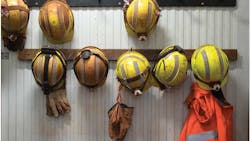Continuous improvement is a familiar phrase to anyone active in manufacturing, and in general it refers to product quality and operating costs: demonstrating continuous improvement in product quality earns a manufacturer new business and the continued appreciation of established customers. Demonstrating continuous improvement in operating cost earns that same manufacturer a better credit rating, a higher share price, and so on.
But continuous improvement is also a standard for evaluating manufacturing workplace safety. No manufacturer can be considered successful without demonstrating its methods for establishing, maintaining, and improving the safety of its workplace. And no successful manufacturer can remain that way without steadily demonstrating workplace safety?
Among forging operations, the best workplace-safety performances are recognized annually by the Forging Industry Association, which identifies its members’ accomplishments with Its FIA Safety Awards, based on statistically verifiable achievements.
FIA collects data on plant safety records via questionnaires delivered annually to all its producer members. Each plant provides data recorded on OSHA Form No. 300, “Summary of Occupational Injuries/ Illnesses for Calendar Year” for U.S. companies, and from Worker’s Compensation Reports for Canadian companies on the questionnaires.
Two rates are computed for each participant: DART -- Days Away from work, work Restrictions, or job Transfer cases -- Incidence Rate, and Frequency Rate. The published report provides a summary for the total industry and detailed company rankings, according to the Incidence Rate by size groups.
FIA presents first-, second-, and third-place Safety Award plaques to plants that have the lowest Recordable Cases Incidence Rate, provided that the DART Incidence Rate falls below the group average. In the event that Recordable Incidence Rates are equal, FIA assigns the award to the plant with the lower DART Incidence Rate.
Awards for improvement are presented too, to plants that demonstrated the greatest decrease in the DART Incidence Rate. This is determined by percentage of improvement by DART Incidence Rate compared with the average of the preceding three years.
A certificate of recognition is awarded to each company that does not earn a first-, second-, or third-place rank, and where the Recordable Incidence Rate falls below the group average — provided that the DART Incidence Rate also falls below the group average.
As for “continuous improvement,” no forging company has to wait for an annual award program to know how it compares to its peers. FIA’s dynamic benchmarking platform (visit www.forging.org/benchmarking) includes the Occupational Injury & Illness Survey: Participating companies can log-in to the platform any time and customize reports, to show the specific information they seek to establish their competitive standing — and to show how much improvement they have made.
About the Author
Robert Brooks
Editor/Content Director - Endeavor Business Media
Robert Brooks has been a business-to-business reporter, writer, editor, and columnist for more than 20 years, specializing in the primary metal and basic manufacturing industries. His work has covered a wide range of topics including process technology, resource development, material selection, product design, workforce development, and industrial market strategies, among others.
Currently, he specializes in subjects related to metal component and product design, development, and manufacturing—including castings, forgings, machined parts, and fabrications.
Brooks is a graduate of Kenyon College (B.A. English, Political Science) and Emory University (M.A. English.)


